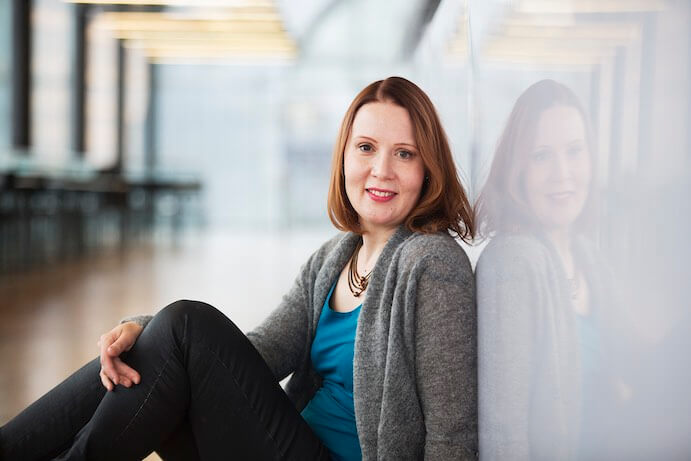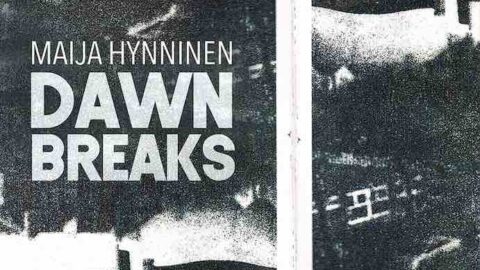Composing with electronics presents a unique set of creative challenges. Rather than presenting challenges of limitations, as acoustic instruments do, electronics do so through a notable lack of limitations. These innumerable possibilities afforded to electronic artists usually invite the same pitfalls: copying successful predecessors too closely, creating tracks with confusingly disparate sonic elements, or–when composing for electronics and acoustic instruments–creating passive, wallpaper-like electronics to sit under an almost (if not entirely) self-contained instrumental solo. It is in considering these common pitfalls that Maija Hynninen’s successes become apparent. Her debut album, Dawn Breaks (Ravello Records), comprises four works with creative, well-integrated electronic elements that not only match the instruments in rhetorical agency, but actively distort the way the listener hears the acoustic instruments to great effect.
The album opens with the airy and spacious Winnowing, which provides captivating electronic complements to the timbral diversity of the piano. This is most notable in the middle section, where undulating electronic lines illusorily color the tones of the piano, almost as if the instrument is coming in and out of tune throughout the piece. The outstanding combination of blend and contrast between the acoustic and electric elements prepares the listener for every shift in focus from one to the other. Pianist Janna Kärkkäinen demonstrates excellent technique and undeniable familiarity with the piece, and her performance further strengthens the marriage of acoustic and electronic elements. The instrumental synergy is somewhat undercut by the mastering, however, as the stereo recording of the piano was not adjusted for the long mid-to-low range passages, causing the piano to skew right overall while the electronics are more carefully spatialized. On the whole, the simultaneous introversion and captivation of “Winnowing” make for a strong first selection.
The strengths Hynninen demonstrates in Winnowing are epitomized in the following … sicut aurora procedit: As the Dawn Breaks. The piece traverses vast sonic territory, but none of it feels out of place. The interplay between the violin and electronics in the opening section creates the ideal texture for the entrance of the antiphon. Hildegard von Bingen’s “O frondens virga” is quoted here, and performed with remarkable grace by soprano Tuuli Lindeberg (prerecorded and set in a reverberant cathedral). Violinist Mirka Malmi’s range as the featured performer is truly exceptional, performing both ethereal and visceral passages with intense emotional musicality. The combined performance elements tell a devastatingly beautiful story.

Following her cameo in the previous piece, Lindeberg takes a central role in Orlando-Fragments, based on Virginia Woolf’s Orlando: A Biography. Her voice and Hynninen’s sound world work well together, and Lindeberg’s excellent sense of pitch and phrase strengthens the engaging melodic language. In this story, the character Orlando lives for 300 years, mysteriously transforming from a man to a woman around age 30. While the poems are based around general themes and the feelings of Orlando, listeners familiar with Woolf’s novel might find themselves cheated of the story’s satirical elements, especially those concerned with gender and class politics. “Orlando-Fragments” instead focuses on a sonic exploration of time and isolation. Hynninen’s exploration of temporal perception is certainly achieved, placing stasis and movement in near-constant juxtaposition throughout the piece. There are several gestures in “Orlando-Fragments” which feel passé (even accounting for its completion in 2010), including long sections of jet whistles from the flute, unconvincing harp glissandi, and transitions between speaking and singing which feel underprepared. However, the piece is engaging and convincing on the whole, and the ensemble’s awareness and musicality create an immersive experience.
Freedom from Fear features a fiery performance from oboist Kyle Bruckmann, and both he and Hynninen show incredible virtuosity in this finale–the highlight of the album. While the oboe is a notoriously difficult (yet rewarding) instrument to write for in noise genres, Hynninen’s composes brilliantly for it, incorporating multiphonics and breathy tones with carefully synergized electronic components. Bruckmann’s familiarity with classical and noise underground genres is apparent here, navigating difficult passages with style and precision. Freedom from Fear is based on recordings of the Burmese politician and Nobel Peace Prize laureate Aung San Suu Kyi. Hynninen integrates recordings from Burmese protests and the words of Aung San Suu Kyi in carefully constructed and highly effective ways, not only reflecting the message of the words spoken, but also complementing the speaker’s timbral qualities with the oboe.
The clear strength in this album as a whole is Hynninen’s conceptualization of electronic timbres. Her composition and performance give the electronic components a true voice, and all of her decisions in this domain feel carefully and effectively chosen, rather than employed simply because they can be. Where many composers create a clear hierarchy of acoustic instruments over electronics (or vice versa), Hynninen’s work in Dawn Breaks excels at placing them in equal standing, allowing for a rare feeling of symbiotic conversation and manipulation.
























